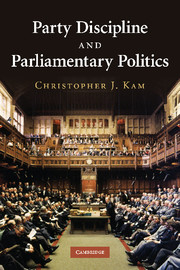Book contents
- Frontmatter
- Contents
- List of figures
- List of tables
- Acknowledgements
- 1 Introduction
- 2 A model of intra-party politics
- 3 Patterns of backbench dissent in four Westminster parliamentary systems, 1945–2005
- 4 Policy preferences and backbench dissent in Great Britain and Canada
- 5 Dissent, constituency service, and the personal vote in Great Britain and New Zealand
- 6 The cost of dissent to the party
- 7 Demotion and dissent in the Canadian Liberal Party, 1991–1997
- 8 Discipline and dissent in the Australian Coalition, 1996–1998
- 9 Career trajectories, socialization, and backbench dissent in the British House of Commons
- 10 Conclusion
- Appendix 1 Comparative statics and proofs
- Appendix 2 Content and construction of ideological scales
- Appendix 3 Sampling and coding of media dissent and discipline
- Appendix 4 Demotion and the parliamentary careers of Canadian MPs
- References
- Index
5 - Dissent, constituency service, and the personal vote in Great Britain and New Zealand
Published online by Cambridge University Press: 03 July 2009
- Frontmatter
- Contents
- List of figures
- List of tables
- Acknowledgements
- 1 Introduction
- 2 A model of intra-party politics
- 3 Patterns of backbench dissent in four Westminster parliamentary systems, 1945–2005
- 4 Policy preferences and backbench dissent in Great Britain and Canada
- 5 Dissent, constituency service, and the personal vote in Great Britain and New Zealand
- 6 The cost of dissent to the party
- 7 Demotion and dissent in the Canadian Liberal Party, 1991–1997
- 8 Discipline and dissent in the Australian Coalition, 1996–1998
- 9 Career trajectories, socialization, and backbench dissent in the British House of Commons
- 10 Conclusion
- Appendix 1 Comparative statics and proofs
- Appendix 2 Content and construction of ideological scales
- Appendix 3 Sampling and coding of media dissent and discipline
- Appendix 4 Demotion and the parliamentary careers of Canadian MPs
- References
- Index
Summary
Introduction
A central assumption of the LEADS model is that dissent insulates the MP from the electoral effects (i.e., lost votes) of unpopular party policies. The qualitative evidence of Chapter 2 suggests that MPs believe that dissent has this capacity, but is there broader empirical evidence to that effect? In this chapter I show that there is. Using data from the UK and New Zealand, I demonstrate that dissent provides MPs with two valuable resources: increased name recognition and higher approval ratings. These effects are independent of MPs' constituency service efforts – though as the British data make clear it is not accurate to think of dissent and constituency service as mutually exclusive activities. On the contrary, British MPs appear to use dissent and constituency service as complementary vote-winning strategies. The New Zealand data are more provocative, however. Dissenting New Zealand MPs enjoyed higher approval ratings among their constituents than loyal MPs and they were able to translate that advantage into an electoral return of 2.2 per cent at the 1993 election. What is especially striking, however, is that the approval effect is driven largely by the positive reaction of non-partisan and weakly partisan voters to dissent. This evidence not only establishes that MPs can use dissent to build up a personal vote that is independent of their parties, it provides a compelling individual-level link between electoral dealignment and parliamentary dissent.
- Type
- Chapter
- Information
- Party Discipline and Parliamentary Politics , pp. 103 - 129Publisher: Cambridge University PressPrint publication year: 2009



